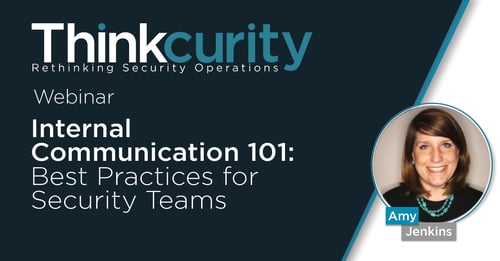Internal communication is vital at every organization, but many businesses can struggle with understanding how to communicate, with who, and in a way that gets their desired results. And that’s because internal communication isn’t always well understood.
Essentially, internal communication is all communication that takes place within your company. That includes communication from management, executive leadership, HR messages, operational messages, and even communication between employees. But communicating isn’t about the delivery of a message, it’s what employees do with that information after it’s received—the activation. This requires an intentional, strategic approach, and that’s where we can help.
For more information on Internal Communication, check out this Thinkcurity webinar on internal communication best practices for security teams.
 What to Communicate
What to Communicate
We like to break communication into two types: need-to-know and nice-to-know. The need-to-know messages are the ones that keep the lights on. That’s your daily ops updates, safety protocols, and important business updates. And this is where you should focus first. Once you have a handle on the need-to-know, you can start to share the nice-to-know content. These messages include employee recognition, acknowledging milestones or anniversaries, sharing ways to get involved in the community or with your security company, and so on.
You likely already deliver one type of communication to your employees regularly and it falls in the need-to-know category. Many small to mid-sized companies focus on tactical communication. These are operational messages and tell employees what they need to do to complete the job. Operational comms include everything from shift changes to renewing certifications and guard training or providing safety updates. This is communication that keeps people safe and helps them do their jobs. So, keep doing it! But it’s also important to communicate the why. Your people are far more likely to comply with something if they fully understand the impact it has on the organization, their peers, and themselves. Whenever you communicate anything, it’s always important to remember to share why it matters and why it’s happening.
Tactical need-to-know communication is a great place to start but your employees likely need and want more. Do they know who their colleagues are? Are they aware of the company’s values? Do employees feel a sense of belonging? Of loyalty? Have they ever heard from the company’s leadership directly? Nice-to-know content helps reinforce company values and creates a sense of purpose for employees.
And it’s important to remember that everything you share (or don’t share) with your employees communicates something. For example:
There is an incident at a business where one of your security guards is stationed. The guard has been blamed in the media for the incident. The company releases an external statement but doesn’t think the incident needs to be discussed internally because it didn’t impact any other guards.
What do you think this says to the other guards working in the organization? The lack of communication allows for rumors to spread and for employees to create the narrative. For example, employees may say that the guard did the right thing but the company is more concerned about their image than supporting their employee. Or the lack of communication may make employees think the company knows they did something wrong and don’t want to take responsibility.
Here’s an example of a great internal communication approach:
The CEO records a video message to share with all employees that clearly states what happened, how the company is addressing the situation, and how the company plans to support employees through training or other programs to ensure they are prepared for any incident that occurs on the job. This approach shows the leadership team values employees enough that they take the time to share what they know about the incident, what it means for the company, and ultimately what they’re going to do to ensure another employee is prepared in the event they are faced with a similar circumstance.
Who Should Be Communicating?
Internal communication is not one person or one team's responsibility. It takes commitment and focus from across the organization, but you definitely need a strategic vision that someone is driving. Having a person or team dedicated to internal communication will ensure that your most important audience, your employees, are always well informed and connected to the organization, its purpose, and its leaders. So, while the communication team may be creating most content and setting the cadence for communication across the organization, they will be working through others to ensure the message is delivered successfully.
It is important for management and leadership to regularly communicate both directly with employees and among themselves. People leaders and managers play a key role in successful internal communication strategies. They are the people employees look to for reassurance, confidence, and even the level of importance they should place on the communication they receive. You want to empower your managers to be successful communicators, so they can confidently answer their employee’s questions and reinforce the messages being delivered.
Executive leaders play a key role in communication as well as seen in the example above. Messages executive leaders should deliver include recognizing teams for a job well done or sharing important company updates and milestones. And leadership directly communicating with all employees can be a great reinforcer of your company’s culture and values. If turnover is something you struggle with, this might be because employees don’t feel connected to the organization, its leadership, and what you stand for. So, this kind of message can have a big impact.
Getting Started with Internal Communication
At the end of the day, internal communication is about one thing—activating employees toward a common goal. That goal could be anything from increasing safety practices to creating a more inclusive security workplace.
And while it’s important to be intentional about what kinds of messages you share, it’s also key to think about how you craft those messages. What we mean by that is that it’s helpful to think about why you’re sending the message in the first place. What do you want your teams to do after receiving the communication? What do you want them to say about it? How do you want them to think about it? And how do you want them to feel? This is the Do, Say, Think, Feel approach.
Here’s how it works. Say, you’ve decided that you want to focus on improving your workplace culture so you retain more employees. So, you decide to send out emails one time per month recognizing employees for a job well done. When you craft those messages, really think about:
DO
Are you encouraging your employees to start congratulating one another more? Or is there another action you hope they take after?
SAY
Are you hoping your supervisors repeat that “thank you” message? Are you hoping your security guards will say that they really appreciate you sending that?
THINK
Do you want employees to think that you care about them?
FEEL
Do you want employees to really feel appreciated and cared for? Or do you hope they feel happy for the employee being recognized?
Go through this thought exercise and consider what you wrote. Does it feel genuine? Do you need to send an additional message to managers to encourage them to take a certain action? Does what you wrote achieve what you hope it will?
Do, Say, Think, Feel Example
Say this is what you wrote to begin with:
We want to recognize Tanya for doing an amazing job. Tanya is a security guard based out of New York at [COMPANY NAME]. Way to go!
Your intentions might be good, but it feels a little impersonal. Other people might not realize why you’re suddenly recognizing Tanya and not them. And it might not have the impact you want.
Instead, try this:
Over the last year, everyone at this company has stepped up, and we appreciate that it hasn’t always been easy. So every month, we are going to recognize one of you for your hard work and achievements. And we will be giving a gift card to that employee as a little way to say ‘thank you.’
This month, we are recognizing Tanya, a security guard based out of Brooklyn, NY at [COMPANY NAME]. Tanya’s supervisor always sings her praises. You are punctual. You have an amazing attitude even on hard days. And the company you are stationed at always leaves a glowing review for you. We are so proud of the work you’ve done. Please, everyone, join me in congratulating Tanya! Keep up the amazing work!
The difference in the second version is that you give everyone the context—this shows that it’s not just about Tanya but about your security company trying to be better at saying ‘thanks.’ It also gives them something to look forward to and strive for. The second version also goes beyond just saying thank you, which doesn’t always come across as genuine, by giving a token of thanks as well. This doesn’t have to break the bank. Even a $25 gift card will still feel like you really mean what you say. It also gives much more detail about the employee you’re recognizing. It takes a little more work, but asking people who Tanya works with for more detail goes a long way towards making the communication feel more genuine and less generic. And last, it includes a call to action. In the copy, you ask people to congratulate Tanya. This is much closer to what you intended when you decided to craft the communication. And it may take a little trial and error and a few times to start seeing the impact.
Conclusion
Mastering internal communication is so important to becoming a strategic and successful security business. But it's important to start sustainably, with a few regular communications, so as not to overwhelm yourself and fall short of employee expectations. To learn more about becoming a great internal communicator, check out this Thinkcurity webinar - Internal Communication 101: Best Practices for Security Teams.
(P.S. For more great content on internal communication, check out theEMPLOYEEapp.com)



